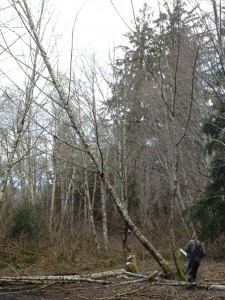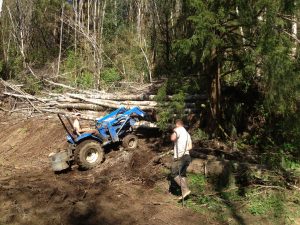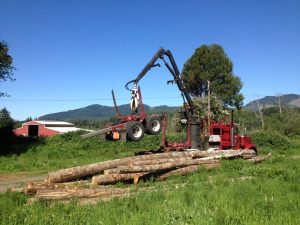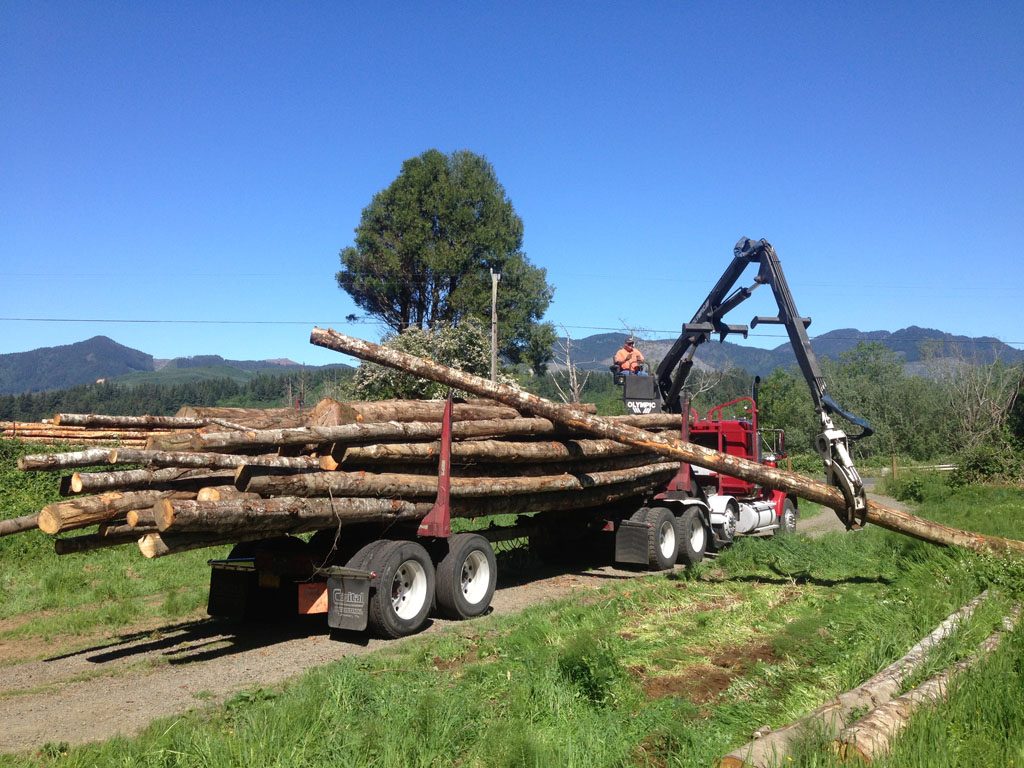When we originally started looking for a piece of land to inhabit, we had this idea that 5-10 acres would be a good size. That’s bigger than anywhere I’ve ever lived before, and we’d have plenty of room to run a market garden/ produce business that we as big as we could ever want (2 or 3 acres of fields, managed intensively, can support a full-time income, believe it or not). Things didn’t work out that way, though, and we ended up finding THIS place… 32 acres, most of which is just a big forest on steep, mountainous terrain. It’s like we bought a farm and got a giant nature preserve thrown in for free.
 The unexpected side effect of this is that I’ve had lots of opportunities to learn about Forestry, Oregon’s major economic engine. Some of this learning has been legal; for instance, I found out a few months ago that we can cut our property taxes in half simply by registering with the county that we have timberland, and maintaining it as such.
The unexpected side effect of this is that I’ve had lots of opportunities to learn about Forestry, Oregon’s major economic engine. Some of this learning has been legal; for instance, I found out a few months ago that we can cut our property taxes in half simply by registering with the county that we have timberland, and maintaining it as such.
Some things I’ve learned have been ecological. Alder, for instance, is a weedy, fast-growing hardwood that tends to just fall over after about 30 years. So it’s pretty normal to harvest it around then, pre-emptively. Also, it’s a pioneer species, meaning that it overtakes scrubby wasteland, then “desirable” noble giants like hemlock and spruce tend to follow it in turn.
But many of the things I’ve learned have been about the business of Logging. When we had to take down a bunch of alder to clear space for an irrigation pond, I was suddenly left with a giant pile of trees and no idea what to do with them. They sat for months, until fate placed me next to the manager of the local sawmill while at a charity dinner.
I was talking about the staggering amount of firewood I need to cut up in the coming months, to prevent it from rotting and being wasted. When he heard it was alder, he perked up. Alder is in demand right now, and that is what his sawmill trades in. He advised me that it does indeed rot quickly, but if it spends the rainy months in its side with the root balls intact (like ours) then it is actually still alive, and won’t die and start rotting until the following summer. He kindly offered to send his lumber grader out to visit us and look at the trees.
A few weeks later, Lee showed up on the site and looked at my trees. “Do you have an axe?” he asked. I did, and I fetched if for him. He took a few deft strokes into one of the fallen trees, and showed me what to look for in the wood to tell if it was still marketable or not. “This is still good,” he said, smiling. “But you shouldn’t wait much longer.” He explained in basic terms what I needed to do, and that started the ball rolling.
The next day I called the State Department of Forestry, to get a logging permit. Yep, I’m a logger now. Luckily for me, the forester remembered me from a visit he made a few years ago, and told me about a fast-track way to do those permits for landowners who are just taking trees down for “maintenance work”. The thing is, you need the permit (and associated identification number) for the mill to accept logs and get them into the taxation system.
 Next, I needed to get the logs “bucked” (cut up into lengths the mill will use, like 20′ and 30′ sections), “skidded” (dragged with a chain or cable to a place where they can be picked up), and “decked” (stacked in a giant pile so they can be loaded onto a log truck). This ended up being a monumental task. Luckily, I have made a lot of cool friends in the last few years, so about a half dozen of us spent two days with tractors and chainsaws bucking, skidding, and decking. I ended up paying all of them except Jared in firewood, which is pretty handy, because after I extracted all the marketable alder from the trees, there was still a MOUNTAIN of other wood left over. Standing deal: one pickup truck load of wood per day of work. 🙂 I still have three years’ worth of firewood siting in my yard, even after paying the troops.
Next, I needed to get the logs “bucked” (cut up into lengths the mill will use, like 20′ and 30′ sections), “skidded” (dragged with a chain or cable to a place where they can be picked up), and “decked” (stacked in a giant pile so they can be loaded onto a log truck). This ended up being a monumental task. Luckily, I have made a lot of cool friends in the last few years, so about a half dozen of us spent two days with tractors and chainsaws bucking, skidding, and decking. I ended up paying all of them except Jared in firewood, which is pretty handy, because after I extracted all the marketable alder from the trees, there was still a MOUNTAIN of other wood left over. Standing deal: one pickup truck load of wood per day of work. 🙂 I still have three years’ worth of firewood siting in my yard, even after paying the troops.
This done, things started slowing down. Summer had begun, and my alder was sitting at the edge of the highway, ready to go, with the sun beating down on it. I was starting to worry; if they sit too long, the wood dries out and gets stained, and then the mill won’t take it. This is when I discovered a problem.
Turns out, even though you see log trucks EVERYWHERE on the roads around here, they aren’t able to help me. Those trucks rely on a large, expensive machine called a “yarder” to load them. It has a big mechaincal arm with a grapple on the end, and big logging operations always have one on hand. Fortunately, there exists a special kind of log truck called a “self-loader”; basically a log truck with a crane attached. Unfortunately, they are few and far between. After weeks of phone calls, talking to loggers, reading the bulletin boards at the chainsaw store, etc. I finally was able to get a guy in Vernonia to agree to take my job. He was hesitant, even when I offered to pay him extra, in cash, for the road time to get here. I’d rather spend an extra $150 on the haul, then lose the whole load to rot.
 So, on the appointed morning, the self-loader rattled down the highway and pulled into our field. I chatted with Steve (the operator) for a bit, then he got to work. Hydraulic braces down, then the crane unfolded. He then picked up the trailer off the back of the rig and extends it. After that, he set the brake on the trailer, and pulled the tractor forward until the trailer length was correct for the size logs he would be hauling.
So, on the appointed morning, the self-loader rattled down the highway and pulled into our field. I chatted with Steve (the operator) for a bit, then he got to work. Hydraulic braces down, then the crane unfolded. He then picked up the trailer off the back of the rig and extends it. After that, he set the brake on the trailer, and pulled the tractor forward until the trailer length was correct for the size logs he would be hauling.
That done, he began loading. It was fun to watch; he’s clearly been doing this for a long time. As he picked up logs, he set certain ones aside for later, and used choice ones to line the bottom of the trailer. He flipped curved ones around to fit better, and jiggled and fitted trunks into the nest he was building. In all, it only took about 40 minutes for him to load 44 logs.

He leaned over from his perch atop the rig, peeked into the back window of the cab, and told me we had about 32,000 pounds of wood. Log trucks have built-in scales, so they can know they aren’t over weight. For Steve, that was a 3/4 load, his rig has an extra axle so it can legally weigh up to 88,000 pounds. He folded up the crane, retracted the hydraulic braces, and began chaining down the load.
The way this works contractually is interesting, and there are a lot of checks and balances to keep any parties from “cheating”. The mill, for example, can’t legally accept logs from me until I give them a logging permit number from the state, so that the state can make sure they get their timber tax money (which the mill sends directly to them, I never see it). They also have an independent, third-party timber assessor on site who measures the load by weight and/ or log size when it arrives, to make sure the mill pays for all the wood it receives. To make sure the hauler doesn’t cheat, the logging companies have a registered “brand” they hammer into the logs when they leave the forest. For small guys like me, the hauler uses his own brand, and hammers the logs right in front of me before he drives away. To make sure the hauler gets paid, the logger/owner tells the mill what rate he negotiated with the hauler, and the mill takes that money out of the payout beforehand and sends a check directly to the hauler before they send the main check to the logger (me). When all was said and done, I sold the mill 2,050 board-feet of lumber, or 16.2 tons of wood. Once the hauler and taxes were paid, I made about $670. No one said logging was easy.
After some chatting, I gave Steve his $150 “bonus” for showing up. “I never really know what I am going to run into when I deal with folks who aren’t loggers,” he said as he counted the money, paused, then counted out $50 of it and handed it back. “When we talked on the phone, I quoted you a little extra, because I didn’t know what I was going to find when I got here, how much extra work I was going to have to do, or what what kind of person you were.”
Yep, I get it; I’ve done that with clients before too. And now that I know what kind of person he is, I’ll call him again the next time.

